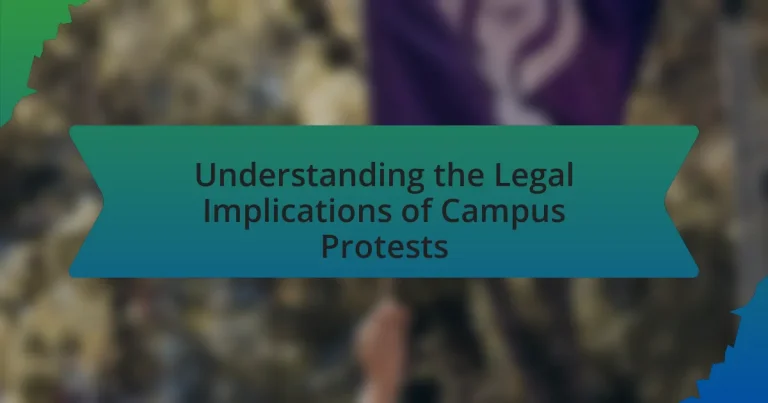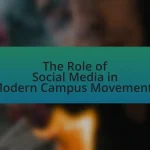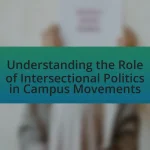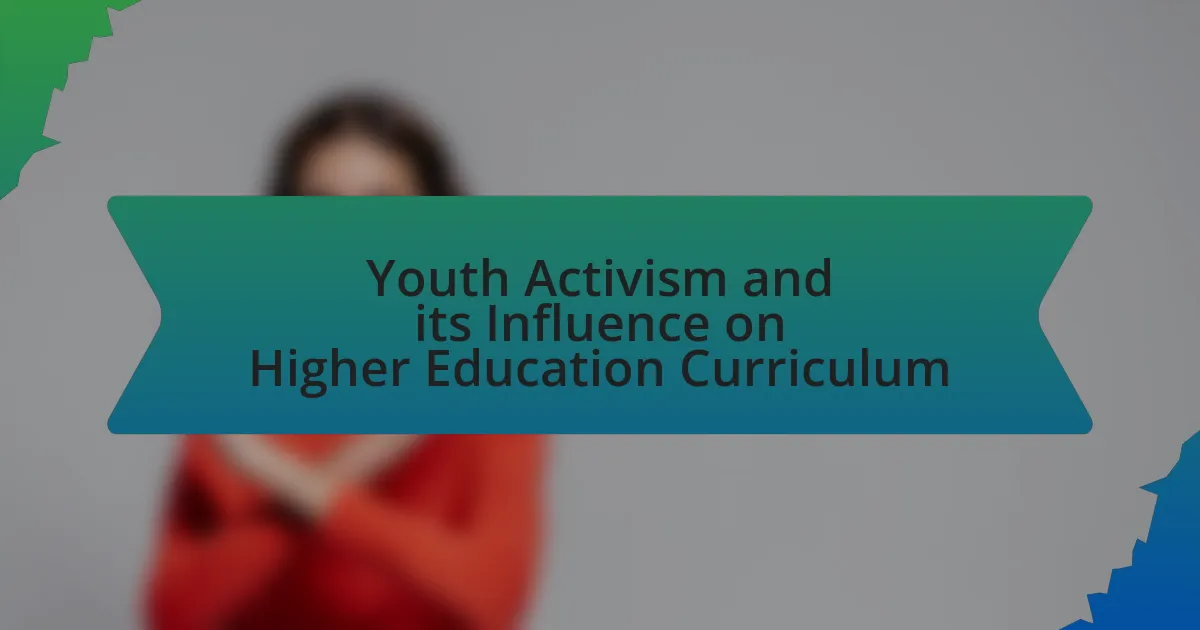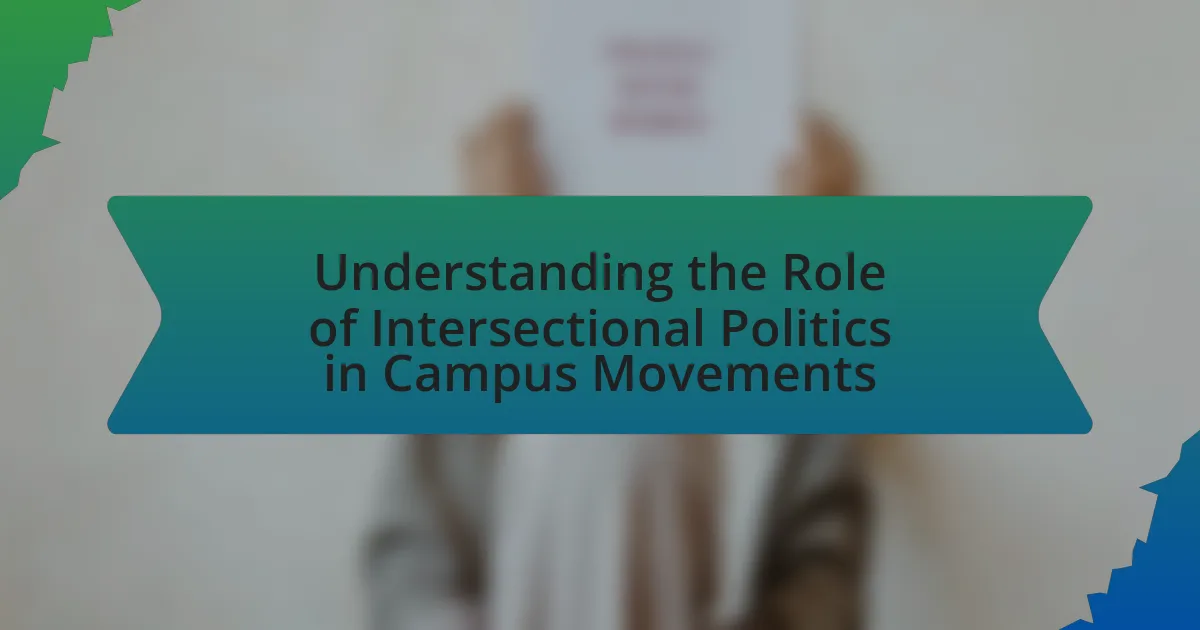The article focuses on the legal implications of campus protests, primarily examining the First Amendment rights of free speech and assembly that protect students’ rights to express their views. It discusses how these rights are subject to limitations imposed by institutions to maintain order and safety, as well as the potential legal consequences of protests, including criminal charges and university disciplinary actions. The article also explores the role of state laws, institutional policies, and judicial precedents in shaping the legal landscape of campus protests, highlighting best practices for conducting protests legally and resources available for students seeking legal assistance.
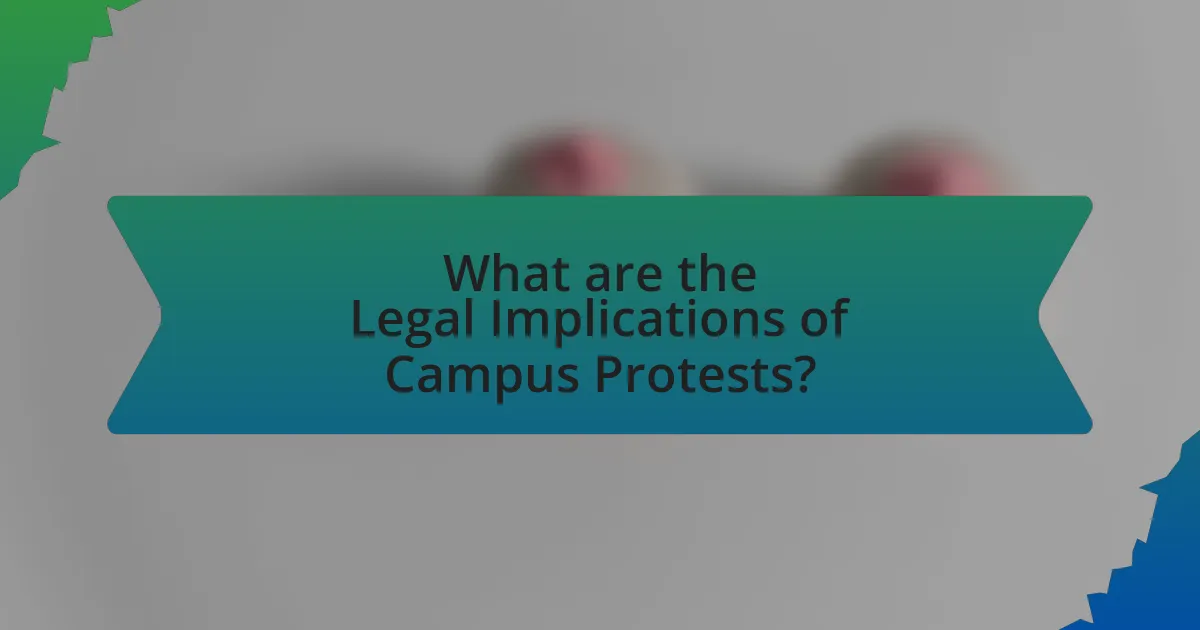
What are the Legal Implications of Campus Protests?
The legal implications of campus protests primarily involve the First Amendment rights of free speech and assembly, which protect students’ rights to express their views. However, these rights are subject to limitations, such as time, place, and manner restrictions imposed by the institution to maintain order and safety. For instance, courts have upheld that universities can regulate protests to prevent disruption of educational activities, as seen in cases like Tinker v. Des Moines Independent Community School District (1969), where the Supreme Court ruled that students do not “shed their constitutional rights to freedom of speech or expression at the schoolhouse gate.” Additionally, institutions may face legal challenges if they are perceived to discriminate against certain viewpoints or if they fail to provide equal access to protest spaces, as established in cases like Rosenberger v. Rector and Visitors of the University of Virginia (1995). Thus, while students have the right to protest, they must navigate institutional policies and potential legal repercussions.
How do laws protect the right to protest on campus?
Laws protect the right to protest on campus primarily through the First Amendment of the U.S. Constitution, which guarantees freedom of speech and assembly. This constitutional protection allows students to express their views and engage in protests without fear of censorship or retaliation from the institution. Additionally, federal laws such as the Higher Education Act and various state laws reinforce these rights by prohibiting discrimination against students based on their political beliefs and ensuring that public universities maintain open forums for expression. Courts have upheld these protections in numerous cases, affirming that public universities must allow peaceful protests as part of their commitment to free expression.
What constitutional rights are involved in campus protests?
The constitutional rights involved in campus protests primarily include the First Amendment rights of free speech, assembly, and petition. These rights allow individuals to express their opinions, gather collectively, and seek change regarding issues of public concern. The U.S. Supreme Court has upheld these rights in various cases, such as Tinker v. Des Moines Independent Community School District (1969), which affirmed students’ rights to free expression in schools, provided it does not disrupt educational activities. Additionally, the Fourteenth Amendment’s Due Process Clause ensures that students are afforded fair treatment in disciplinary actions related to their participation in protests.
How do state laws vary regarding campus protests?
State laws regarding campus protests vary significantly in terms of regulations, permitted locations, and the extent of free speech protections. For instance, some states have enacted laws that explicitly protect the right to protest on public university campuses, while others impose restrictions that can limit the time, place, and manner of such protests. In states like California, the Leonard Law protects student free speech rights at private universities, whereas states like Florida have introduced legislation that penalizes universities for not allowing free speech, reflecting a more permissive stance. Additionally, some states have laws that criminalize certain protest activities, such as blocking traffic or trespassing, which can lead to arrests and legal consequences for protesters. These variations highlight the complex legal landscape surrounding campus protests, influenced by state-specific interpretations of the First Amendment and local governance policies.
What are the potential legal consequences of campus protests?
Campus protests can lead to various legal consequences, including criminal charges, civil liability, and university disciplinary actions. Criminal charges may arise from violations of laws such as trespassing, disorderly conduct, or obstruction of justice, which can result in fines or imprisonment. Civil liability may occur if protests cause property damage or personal injury, leading to lawsuits against individuals or organizations involved. Additionally, universities may impose disciplinary actions, such as suspension or expulsion, against students who violate campus policies during protests. These legal outcomes underscore the importance of understanding both the rights and responsibilities associated with exercising free speech in a campus setting.
What charges can protesters face during campus demonstrations?
Protesters can face charges such as trespassing, disorderly conduct, and obstruction of justice during campus demonstrations. Trespassing occurs when individuals enter or remain on campus property without permission, which can lead to legal repercussions. Disorderly conduct involves actions that disrupt the peace or safety of others, potentially resulting in fines or arrest. Obstruction of justice may apply if protesters interfere with law enforcement activities or investigations. These charges are supported by various state laws and university policies that govern behavior on campus.
How can universities respond legally to protests?
Universities can respond legally to protests by implementing policies that balance the right to free speech with the need to maintain campus safety and order. These policies should clearly outline the procedures for organizing protests, including the requirement for permits, designated areas for demonstrations, and guidelines for behavior during protests. Legal frameworks, such as the First Amendment in the United States, protect the rights of individuals to assemble and express their views, but universities must also adhere to state laws and institutional regulations that govern public safety and disruption of educational activities. For instance, a university may invoke time, place, and manner restrictions to ensure that protests do not interfere with classes or other university functions, as established in various court rulings, including the 1972 case of Papish v. Board of Curators of the University of Missouri.
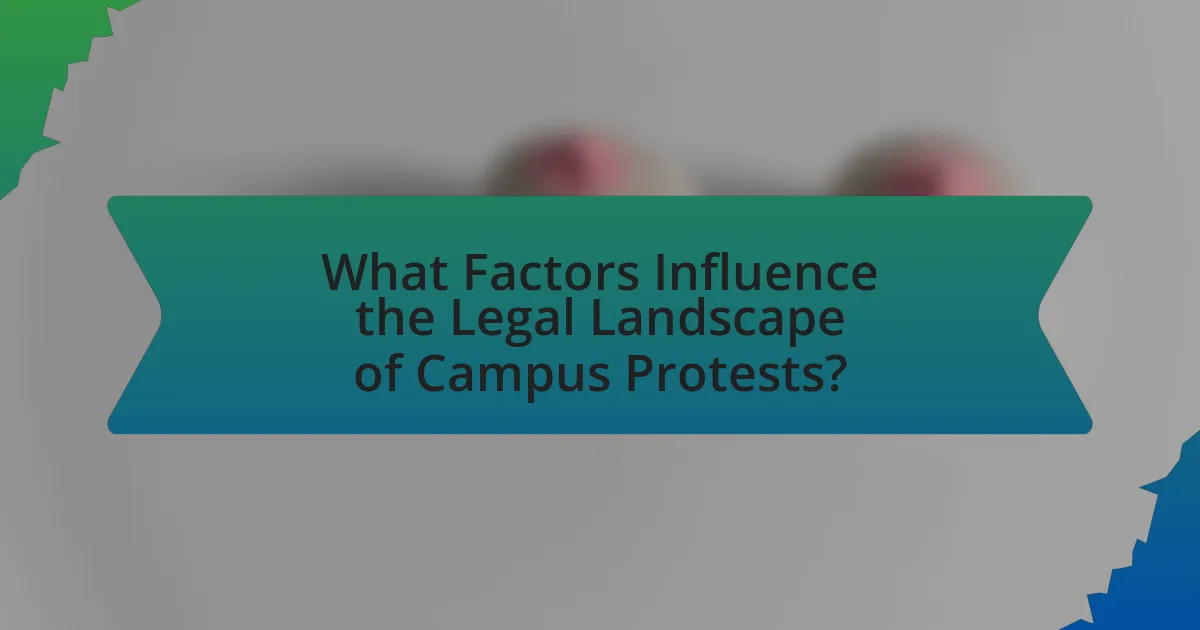
What Factors Influence the Legal Landscape of Campus Protests?
The legal landscape of campus protests is influenced by several factors, including constitutional rights, institutional policies, state laws, and judicial precedents. Constitutional rights, particularly the First Amendment, protect freedom of speech and assembly, which are fundamental to protest activities. Institutional policies, such as those governing time, place, and manner restrictions, can dictate how and when protests occur on campus. State laws may also impose additional regulations or protections for protest activities, varying significantly across jurisdictions. Judicial precedents, established through court rulings, further shape the interpretation and enforcement of these rights and regulations, often balancing the rights of protesters with the interests of the institution and public safety. For example, the Supreme Court case Tinker v. Des Moines Independent Community School District (1969) affirmed students’ rights to free expression in schools, influencing how campus protests are legally approached.
How does the nature of the protest affect its legal standing?
The nature of the protest significantly affects its legal standing by determining whether it is protected under the First Amendment or subject to restrictions. Protests that are peaceful and organized in designated public areas typically receive greater legal protection, as established by cases like Tinker v. Des Moines Independent Community School District, which affirmed students’ rights to free expression. Conversely, protests that involve violence, property damage, or disruption of educational activities may face legal consequences, as courts have upheld the authority of educational institutions to maintain order and safety. Thus, the specific characteristics of a protest, including its location, manner, and message, directly influence its legal recognition and the potential for enforcement actions against participants.
What distinguishes peaceful protests from unlawful assemblies?
Peaceful protests are characterized by the absence of violence and the expression of dissent within the bounds of the law, while unlawful assemblies involve actions that disrupt public order or violate legal statutes. Peaceful protests typically adhere to regulations regarding time, place, and manner, allowing participants to express their views without infringing on the rights of others. In contrast, unlawful assemblies may include acts such as blocking traffic, vandalism, or inciting violence, which can lead to legal repercussions. The distinction is crucial in legal contexts, as peaceful protests are often protected under free speech rights, whereas unlawful assemblies can be subject to police intervention and arrest.
How do protest tactics impact legal outcomes?
Protest tactics significantly influence legal outcomes by shaping public perception and judicial responses. For instance, nonviolent protests often garner public sympathy and can lead to favorable legal rulings, as seen in the civil rights movement, where peaceful demonstrations resulted in landmark decisions like Brown v. Board of Education. Conversely, aggressive or disruptive tactics may provoke legal repercussions, such as arrests or injunctions, as evidenced by the 2017 protests at the University of California, Berkeley, which led to numerous legal actions against participants. Thus, the choice of tactics directly correlates with the legal consequences faced by protesters.
What role do university policies play in regulating protests?
University policies play a crucial role in regulating protests by establishing guidelines that govern the time, place, and manner of demonstrations on campus. These policies are designed to balance the rights of individuals to express their views with the need to maintain order and safety within the university environment. For instance, many universities require advance notice for protests, designate specific areas for demonstrations, and outline permissible activities to prevent disruptions to academic functions. Such regulations are often informed by legal precedents, such as the First Amendment rights in the United States, which protect free speech while allowing institutions to impose reasonable restrictions.
How can universities create policies that comply with legal standards?
Universities can create policies that comply with legal standards by conducting thorough legal reviews and engaging legal experts during the policy development process. This approach ensures that the policies align with federal, state, and local laws, including First Amendment rights and anti-discrimination statutes. For instance, the U.S. Department of Education provides guidelines on Title IX compliance, which universities must follow to avoid legal repercussions. Additionally, universities should regularly update their policies to reflect changes in legislation and court rulings, ensuring ongoing compliance.
What are the implications of violating university protest policies?
Violating university protest policies can lead to disciplinary actions against students, including suspension or expulsion. Universities typically enforce these policies to maintain order and safety on campus, and violations may result in legal consequences as well, such as arrest or fines if local laws are breached. For instance, a study by the American Association of University Professors highlights that institutions often have specific guidelines that, when disregarded, can trigger a range of penalties, reinforcing the importance of adhering to established protest protocols.
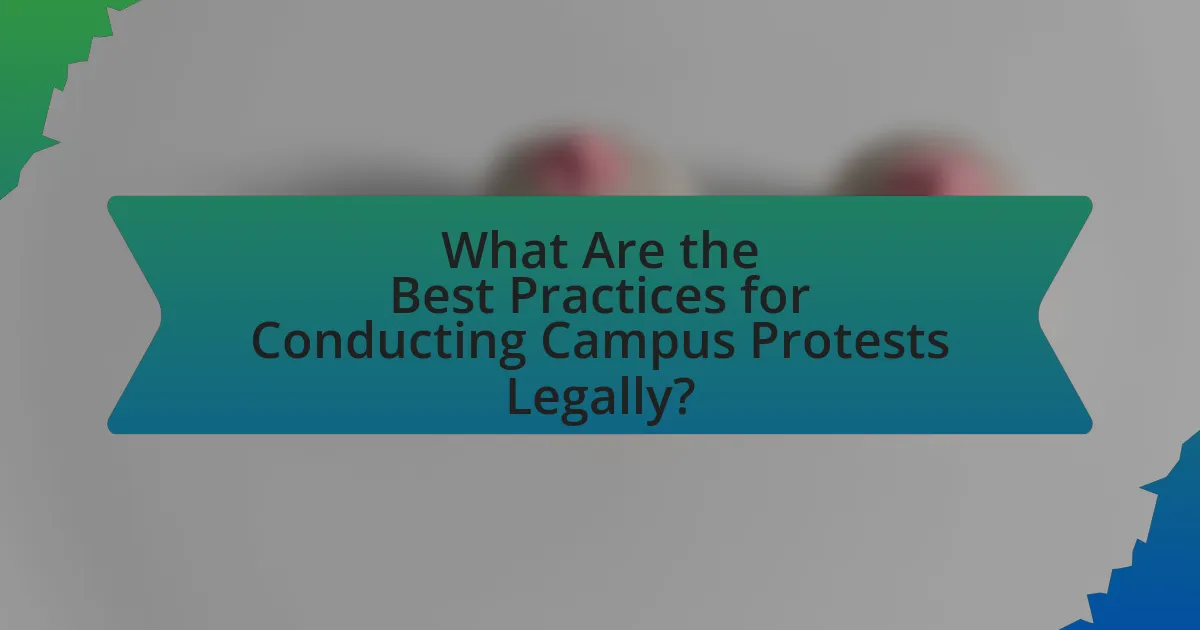
What Are the Best Practices for Conducting Campus Protests Legally?
The best practices for conducting campus protests legally include obtaining necessary permits, understanding campus policies, and ensuring the protest does not disrupt educational activities. Obtaining permits is crucial as many institutions require prior approval for gatherings, which helps in maintaining order and legality. Understanding campus policies is essential because each institution has specific rules regarding protests, including designated areas and time restrictions. Additionally, ensuring that the protest does not interfere with classes or other campus functions is important to comply with laws regarding free speech while respecting the rights of others. These practices help mitigate legal risks and promote a constructive dialogue on campus issues.
How can organizers ensure compliance with legal requirements?
Organizers can ensure compliance with legal requirements by thoroughly researching and understanding applicable laws and regulations governing protests on campus. This includes familiarizing themselves with local ordinances, university policies, and state laws regarding free speech, assembly, and permits. For instance, many universities require organizers to submit a request for a permit to hold a protest, which outlines the event’s details and ensures it aligns with institutional guidelines. Additionally, consulting with legal experts or university legal counsel can provide clarity on specific legal obligations and help mitigate risks associated with non-compliance.
What steps should be taken to notify authorities about a protest?
To notify authorities about a protest, individuals should first determine the appropriate local government agency or law enforcement department responsible for handling such notifications. Next, they should prepare a formal notification that includes essential details such as the date, time, location, purpose of the protest, and expected number of participants. This notification should be submitted in writing, either via email or through a designated online form, depending on local regulations.
Many jurisdictions require this notification to be submitted a certain number of days in advance, often ranging from 48 hours to two weeks prior to the event, to allow authorities to plan for public safety and traffic management. Additionally, it is advisable to keep a copy of the notification for personal records. Following these steps ensures compliance with local laws and helps facilitate a safe protest environment.
How can protesters protect themselves legally during demonstrations?
Protesters can protect themselves legally during demonstrations by understanding their rights and adhering to local laws. Knowing the First Amendment rights, which include freedom of speech and assembly, is crucial, as these rights provide a legal foundation for peaceful protests. Additionally, protesters should document their actions and interactions with law enforcement, as this can serve as evidence if legal issues arise. Familiarizing themselves with local ordinances regarding permits and designated protest areas can also prevent legal complications. Legal observers, often affiliated with organizations like the National Lawyers Guild, can provide on-site legal support and advice, further enhancing legal protection during demonstrations.
What resources are available for understanding protest rights?
Resources available for understanding protest rights include legal guides, government websites, and nonprofit organizations focused on civil liberties. For instance, the American Civil Liberties Union (ACLU) provides comprehensive resources detailing the rights of individuals to assemble and protest, including state-specific guides. Additionally, the National Lawyers Guild offers legal support and educational materials regarding protest rights. Government websites, such as those of local law enforcement agencies, often outline regulations and rights related to public demonstrations. These resources collectively ensure individuals are informed about their legal rights when participating in protests.
Where can students find legal assistance regarding campus protests?
Students can find legal assistance regarding campus protests through their university’s legal aid office or student affairs department. Many universities provide resources such as legal clinics or access to attorneys who specialize in student rights and protest laws. Additionally, organizations like the American Civil Liberties Union (ACLU) offer guidance and support for students facing legal issues related to protests. These resources are designed to help students understand their rights and navigate any legal challenges that may arise during campus demonstrations.
What organizations advocate for protest rights on campuses?
Organizations that advocate for protest rights on campuses include the American Civil Liberties Union (ACLU), the Foundation for Individual Rights in Education (FIRE), and the Student Press Law Center (SPLC). The ACLU works to protect free speech rights, including the rights of students to protest, by providing legal assistance and advocacy. FIRE focuses on defending individual rights in higher education, emphasizing the importance of free expression and assembly on campuses. The SPLC supports student journalists and advocates for their rights, including the right to protest and report on issues affecting their communities. These organizations provide resources, legal support, and advocacy to ensure that students can exercise their rights to protest effectively and safely.
